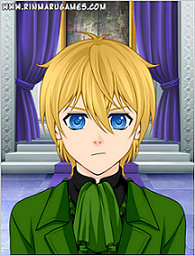Looking on the Internet maybe a few months ago, I wanted to know what would be the best Nintendo DS games. I've had already heard of many games and tried some but not all and when I saw Professor Layton in the list I thought I'd give it a try. That was worth my time, as I've finished the game and found it interesting enough to decide to write a review about it! Now that reminds me of a puzzle...
Story: 7
The story starts with our two heroes or er... gentlemen sitting in a car: Professor Hershel Layton and his young assistant Luke Triton. Luke asks professor Layton why they are going to solve an inheritance dispute. But professor Layton claims it's more difficult than that.
Two months ago, a baron by the name of August Reinhold died and he claimed that whoever could find the 'golden apple' in a town called St. Mystere would inherit his total inheritance. Lots of people have tried to look for it but to no avail: Nobody could find a thing. It was then that the wife of August, Dahlia Reinhold, decided to write a letter to professor Layton and ask him to look for it, as he's well known for solving puzzles and mysteries, even though he claims he isn't a detective professor Layton admits to find out what is the golden apple with Luke.
When Layton and Luke arrive they notice that St. Mystere is a strange village: The townspeople are obsessed with puzzles, people go missing but suddenly return later without remembering anything, and there is a strange and huge tower in the centre of the village that everybody is scared of. What's going on in the village? Can the professor and Luke solve the secret behind St. Mystere and the golden apple?
While the story is pretty interesting, I have to say that the story starts out a bit slow. It isn't until later in the game that a lot of the mysterious things I mentioned take place. The best thing about the story in my opinion is that the biggest mystery of the village is solved just before the end of the game, so before you're there you can get confused and excited about all the mysteries that take place. There are also a lot of plot twists and there is one thing that you never could expect but you only learn of after certain events have taken place, which also shows the originality of the story. I am not really sure if the stories in the sequels are better, as I'm now playing the second game (Diabolical Box) and I haven't finished that one yet, and I haven't played other games in the series.
Graphics: 8
The graphics are pretty good most of the time, and the characters have original and funny designs: from short and buff people to long and slender people, you'll meet all kinds of people in the games. Not only that, but each character has little moves they make when they are talking or just being idle, like yawning, scratching their heads or heavily breathing. Most of the environments look crisp as well, although there are some points where there are too many things in one 'room' and things look a bit blurry, that's the only thing that bothers me a bit, and I've noticed that the later games slowly start to get better graphics. This game its graphics are at its best when there are animated cutscenes, where they look nicely hand drawn and very alive. I think the game is very smart for going for a drawn environment, as 3D environments like in the Zelda games on the DS still look a bit... odd.
Sound: 9
I think what makes the game its atmosphere so strong is the music. While they're just as few as 20 tracks, they sound very different from each other and give the game more emotion. The music was made with a French style in mind and that can be heard back in the game. The game has music that sounds like it could have been made 100 years ago, making the music sound a bit more classy and old-fashioned, which goes well with the game and Professor Layton himself; piano, accordion, violins and bells can be heard in most of the themes, making them very memorable. The only theme that can get a bit irritating is the puzzle theme, as it's a theme that is short and sounds like a musical box, so after hearing it for a while it can get somewhat frustrating for you.
As for sounds, the game doesn't have many sounds, but the sounds sound good and they always come at the right place. There wasn't a sound that confused me because it felt out of place.
Gameplay: 8
I was wondering how the game would combine a story with puzzles all the time and they've done it in a pretty smart way. When the story starts and you talk to people they will tell stuff and often offer you a puzzle. Luckily, you can choose for 99% of the puzzles if you want to stop with them when you want to save beforehand. You will sometimes find puzzles when you're clicking on certain things in the environment, but luckily you can always make these hidden puzzles later on if you want to. And throughout the game you can find hint coins, and with these coins you buy three hints per puzzle if you need help, and those coins are of great help. Now you might be wondering: 'But wait, what if I forgot a certain puzzle and now the character that had a puzzle for me is giving me another one?'. Well, don't fear, because all unsolved puzzles that can't be found back at their original place or person will be sent to a lady called Granny Riddleton, an old lady with a witch hat who has the power to put unsolved puzzles in a tiny shack, and you can always visit her back.
But luckily, puzzle solving isn't the only thing that can be done in the game. In the beginning of the game professor Layton and Luke will constantly find all kinds of strange gizmos which can be used to build something that will be very helpful for you, they also will find puzzle pieces of a painting that they have to complete and the last thing that can be done is doing a kind of design game where you have to put furniture in a room and when Professor Layton and Luke are both perfectly happy with the layout of their room you will win. The gizmos, painting pieces and the furniture can be won by of course, solving puzzles. And when you've completed the things I mentioned above you will get extra, optional and superhard puzzles for the real puzzle freaks. Those are really challenging but then again, it's mentioned those are the hardest puzzles in the whole game. And when you have completed all 134 puzzles in the game, you will open up one last puzzle, the famous Klotski puzzle, one of the hardest sliding puzzles in the world.
Addictiveness: 8
The game is addictive if you like to make puzzles and if you have the patience to spend 15-20 minutes or sometimes even longer on the hardest puzzles. There are all kinds of puzzles: mathematics puzzles, sliding puzzles, chessboard puzzles and also some puzzles that just require some logical thinking to name some, which are the funniest puzzles in my opinion. The sidequests mentioned in the gameplay section are also funny to do and don't require as much think work as the puzzles. You're free to make the puzzles you like, although there are some points in the game where characters will say things as 'I see you haven't completed 29 puzzles yet, in that case I can't tell you what you need to know.' which can be annoying though. The only point I found the puzzles annoying was when I wanted to continue with the story as quick as possible and constantly ran into games, so be prepared to face a lot of puzzles when you start this game (but with 135 puzzles you've probably expected this already).
Depth: 8
The game itself without puzzles and extra stuff would probably take about 1-2 hours which isn't very long of course. However, if you want to complete all the puzzles (like I did) then you can expect to spend about 25-30 hours completing this game, and when you add in the sidequests you can spend another 30 minutes playing this game. Opening extra, difficult puzzles is also interesting and gives the game more depth, and when you complete the game you can look at character profiles, chill out on some music, rewatch cutscenes and so on as well. While I think the game could've been a bit bigger, it's definitely impressive for the first game in the series.
Difficulty: 9
Most of the game its difficulty is spot on. In the beginning you will mostly get some easy puzzles to make you familiar with the game and its puzzles and near the end of the game you will have to solve some pretty tough ones, that will make you think for a while. The gizmo and painting sidequest are too easy as the gizmo sidequest is just clicking on new gizmos you found and the painting has 20 pieces, making it a very easy puzzle to solve. The furniture puzzle is very fun and not too easy though, as there are things that make it sound like rather Luke or the professor prefers it in his room, but actually the other person needs it. And if you think the game is too easy, challenge yourself with the extra puzzles, so you can spend about 2-3 more hours on the game.
Well, that wraps it up for this review, I had a lot of fun playing this game and I recommend it for people who want a game where they have to think a lot and uses a nice approach to do so. Even though the game is rated E for everyone, I think that when you're 13 years or older that you'll be able to finish the game and to finish the puzzles without too many problems, because you will need some basic math skills which make some of the puzzles easier.
I hope you liked my review and if you see any flaws, want to compliment me, have feedback or want to mention something else, then reply and tell what's on your mind! This was juuldude, and I will see you again in my next review!
|
 juuldude is Offline
| ID: 1148746 | 1792 Words
juuldude is Offline
| ID: 1148746 | 1792 Words
 juuldude is Offline
juuldude is Offline
 juuldude is Offline
| ID: 1148748 | 67 Words
juuldude is Offline
| ID: 1148748 | 67 Words
 juuldude is Offline
juuldude is Offline
 TheReaper7290 is Offline
| ID: 1148853 | 68 Words
TheReaper7290 is Offline
| ID: 1148853 | 68 Words
 TheReaper7290 is Offline
TheReaper7290 is Offline
 Uzar is Offline
| ID: 1148883 | 52 Words
Uzar is Offline
| ID: 1148883 | 52 Words
 Uzar is Offline
Uzar is Offline
 Spicy is Offline
| ID: 1149454 | 37 Words
Spicy is Offline
| ID: 1149454 | 37 Words
 Spicy is Offline
Spicy is Offline
 juuldude is Offline
| ID: 1149772 | 352 Words
juuldude is Offline
| ID: 1149772 | 352 Words
 juuldude is Offline
juuldude is Offline
 juuldude is Offline
| ID: 1151476 | 45 Words
juuldude is Offline
| ID: 1151476 | 45 Words
 juuldude is Offline
juuldude is Offline


 User Notice
User Notice 












 .
. 

